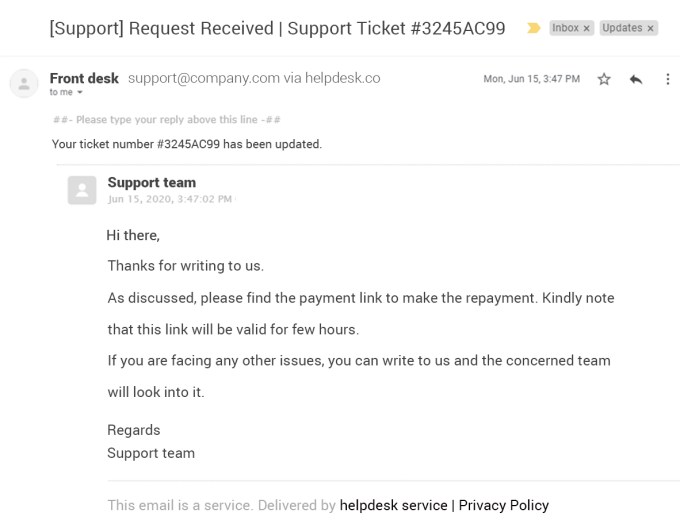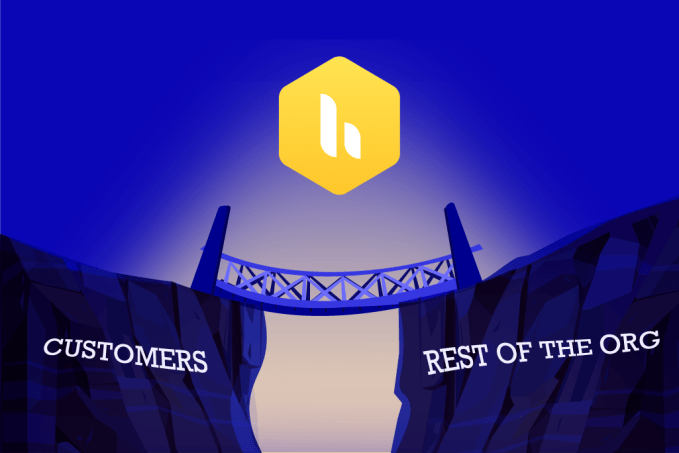The term helpdesk software, by definition, is used to describe software that helps you manage requests coming from customers. It is a reference to a real world desk in a physical office, manned by a team offering help to customers walking in. That it is a dedicated ‘desk’ for customer interactions also means that it stops most of the company from having direct access to customers.
Modern software to manage customer support is built on the same paradigm of using a dedicated team of agents to shield everyone in the organization from customer interactions.
While such shielding can look extremely useful in allowing people to focus on their core jobs, organizations are increasingly realizing that customer happiness is everyone’s job. The alignment to customer needs and satisfaction moves to a different level altogether when people who actually build a product or render a service can interact directly with customers.
In addition to that, there is another range of businesses where it is a must have. Professional services like architecture and planning, freight management, financial services or real estate consultancy rely on service providers being able to directly interact with customers. In such an environment, helpdesk software that is built primarily for ‘customer support specialists’ to shield others from having direct customer interactions can actually come in the way of great customer experience.
In the rest of the post, I attempt to break down the ways in which your helpdesk is getting in the way of great customer interactions that are useful to your customers and are great learning experiences for everyone in your organization.
Helpdesks silo customer communication
Helpdesks rely on all communication between your organization and its customers happening through a support email address such as support@company.com or order@company.com. The helpdesk then makes all such communication available to ‘agents’ who specialize in customer support and cut off the rest of your organization from customer communication.
The end result of this is that helpdesks turn into silos that contain all customer interactions, and it becomes extremely difficult for anyone who is not a customer support agent or specialist to get access to, learn from, or help customers directly.
Imagine a scenario where a customer query about a product feature not working needs to be escalated to an engineer, and the engineer needs to ask further questions, provide more information, and subsequently a resolution to the problem.
A helpdesk would make it extremely difficult for the engineer in this case to directly communicate with the customer. This can lead to the customer getting a sub-par experience, and the engineer missing a valuable opportunity to interact with and learn from a customer.
A roadblock for collaboration towards an org-wide CX vision
In today’s hyper-competitive environment, businesses need to demonstrate an organization-level commitment to Customer Experience in order to have an edge over competitors and gain customer loyalty.
When your entire organization is focussed on customer experience as a north star, there’s greater alignment and synergy between different functions and everyone knows how their work impacts the lives of the customers.
A direct impact of siloing of customer communication into helpdesk products is that collaboration around customer requests takes a significant hit. With only agents or support specialists having access to customer interactions in a helpdesk, it is very difficult for them to seek answers, clarifications, and advice from others in the organization to help customers better.
Imagine a freight or shipping company customer reaching out to know what would be the additional charges to modify the order, and how that would impact delivery timelines. In such a case, the customer support agent would need to interact with multiple parties within the company to serve the customer. With a helpdesk, it would be extremely difficult for the agent to loop in other parties to help the customer.
Such collaboration between different teams and stakeholders in a company is very important to provide a great experience to customers. Helpdesk products, designed with the philosophy of containing customer communication, very naturally get in the way of such collaboration.
Helpdesks make peoples’ lives difficult
Which of the following have you (not) come across:
- “Reply above this line to add a response”
- “Please quote the ticket number in all correspondence”
- “Could you please explain the problem you are facing” (after having explained it already in a previous email)
- Fonts and formatting straight from the 90s
Each of these make customer service impersonal, less than useful, and sometimes, downright embarrassing. And behind each of these is a helpdesk software quirk.
A large number of these quirks are because a big part of what helpdesk products do is act like an email client, without being as good at it as Gmail or Outlook is. Tying email communication into a single conversation thread is a challenge that almost all helpdesks have a lot of trouble dealing with, leading to some really inelegant solutions.
Most helpdesks also imbed formatting into emails sent out through them which makes them look unnatural.

Image Credits: Hiver
A new way of looking at customer communication.

Image Credits: Hiver
For customer happiness to be everyone’s responsibility, it’s imperative that organizations go beyond conventional helpdesks and rethink how they handle customer communications.
And that’s precisely what a customer service solution like Hiver helps you achieve.
Since Hiver works within Gmail and doesn’t require teams to switch to an external platform, customer interactions are no longer ‘shielded’ and made easily accessible across the organization. Moreover, this helps support team members easily collaborate with non-customer facing teams and share all the necessary context — giving them that much-needed customer-facing exposure.
When you have such organization-wide commitment to serving customers, truly delightful customer experiences start to take shape.
By Niraj Ranjan, CEO and Co-founder, Hiver
Hiver is a Gmail-centric customer service solution that helps teams across the organization collaborate on shared inboxes like services@, orders@, support@. It’s the most frictionless, natural way for teams to handle customer email communication as it works right inside Gmail. It helps teams collaborate better and make sure all queries are answered on time, by the right people.